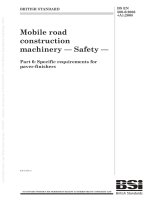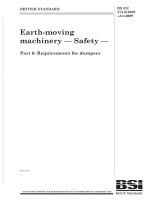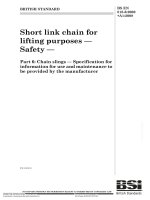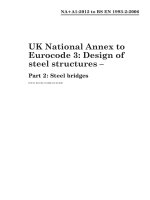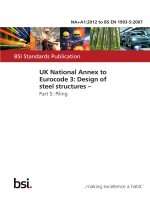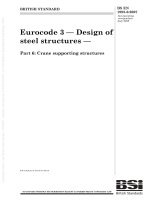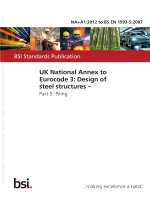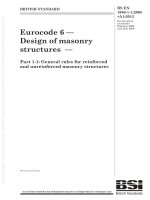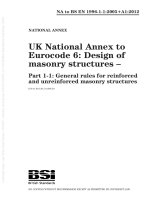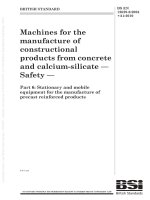Bsi bs en 62282 6 100 2010 + a1 2012
Bạn đang xem bản rút gọn của tài liệu. Xem và tải ngay bản đầy đủ của tài liệu tại đây (5.94 MB, 376 trang )
BS EN 62282-6-100:2010+A1:2012
BS EIncNorpo6ra2tin2g 8cor2rig-e6nd-u1m0De0ce:m2b0er 120011
Incorporating corrigendum December 2011
BSI Standards Publication
Fuel cell technologies
Part 6-100: Micro fuel cell power systems
— Safety
NO COPYING WITHOUT BSI PERMISSION EXCEPT AS PERMITTED BY COPYRIGHT LAW
raising standards worldwide™
BS EN 62282-6-100:2010+A1:2012 BRITISH STANDARD
National foreword
This British Standard is the UK implementation of
EN 62282-6-100:2010+A1:2012. It supersedes BS EN 62282-6-100:2010
which is withdrawn. It is identical to IEC 62282-6-100:2010, incorporating
amendment 1:2012 and corrigendum December 2011.
The start and finish of text introduced or altered by corrigendum is indicated
in the text by tags. Text altered by IEC corrigendum December 2011 is
indicated in the text by .
The start and finish of text introduced or altered by amendment is indicated
in the text by tags. Tags indicating changes to IEC text carry the number
of the IEC amendment. For example, text altered by IEC amendment 1 is
indicated by .
The UK participation in its preparation was entrusted to Technical Committee
GEL/105, Fuel cell technologies.
The UK committee voted to abstain in the adoption stage ballot for
EN 62282-2-100. The positive result of the CENELEC ballot resulted in the
publication of this standard.
A list of organizations represented on this committee can be obtained on
request to its secretary.
This publication does not purport to include all the necessary provisions of a
contract. Users are responsible for its correct application.
© The British Standards Institution 2013.
Published by BSI Standards Limited 2013
ISBN 978 0 580 78534 4
ICS 27.070
Compliance with a British Standard cannot confer immunity from
legal obligations.
This British Standard was published under the authority of the Standards
Policy and Strategy Committee on 31 May 2010.
Amendments/corrigenda issued since publication
Date Text affected
29 February 2012 Implementation of IEC corrigendum December 2011
31 March 2013 Implementation of IEC amendment 1:2012 with
CENELEC endorsement A1:2012
EUROPEAN STANDARD EN 62282-6-100
NORME EUROPÉENNE
EUROPÄISCHE NORM April 2010
ICS 27.070
English version
Fuel cell technologies -
Part 6-100: Micro fuel cell power systems -
Safety
(IEC 62282-6-100:2010)
Technologies des piles à combustible - Brennstoffzellentechnologien -
Partie 6-100: Système à micro-piles Teil 6-100: Mikro-Brennstoffzellen-
à combustible - Sécurité Energiesysteme - Sicherheit
(CEI 62282-6-100:2010) (IEC 62282-6-100:2010)
This European Standard was approved by CENELEC on 2010-04-01. CENELEC members are bound to comply
with the CEN/CENELEC Internal Regulations which stipulate the conditions for giving this European Standard
the status of a national standard without any alteration.
Up-to-date lists and bibliographical references concerning such national standards may be obtained on
application to the Central Secretariat or to any CENELEC member.
This European Standard exists in three official versions (English, French, German). A version in any other
language made by translation under the responsibility of a CENELEC member into its own language and notified
to the Central Secretariat has the same status as the official versions.
CENELEC members are the national electrotechnical committees of Austria, Belgium, Bulgaria, Croatia, Cyprus,
the Czech Republic, Denmark, Estonia, Finland, France, Germany, Greece, Hungary, Iceland, Ireland, Italy,
Latvia, Lithuania, Luxembourg, Malta, the Netherlands, Norway, Poland, Portugal, Romania, Slovakia, Slovenia,
Spain, Sweden, Switzerland and the United Kingdom.
CENELEC European Committee for Electrotechnical Standardization
Comité Européen de Normalisation Electrotechnique
Europäisches Komitee für Elektrotechnische Normung
Management Centre: Avenue Marnix 17, B - 1000 Brussels
© 2010 CENELEC - All rights of exploitation in any form and by any means reserved worldwide for CENELEC members.
Ref. No. EN 62282-6-100:2010 E
BBSS EENN6622228822-6--61-0100:020:21001+0A1:2012 -–22- –
EENN 6622228822-6-6-1-0100:02:021001+0A(1E:2)012 (E)
Foreword
The text of document 105/255/FDIS, future edition 1 of IEC 62282-6-100, prepared by IEC TC 105, Fuel
cell technologies, was submitted to the IEC-CENELEC parallel vote and was approved by CENELEC as
EN 62282-6-100 on 2010-04-01.
Attention is drawn to the possibility that some of the elements of this document may be the subject of
patent rights. CEN and CENELEC shall not be held responsible for identifying any or all such patent
rights.
The following dates were fixed:
– latest date by which the EN has to be implemented (dop) 2011-01-01
at national level by publication of an identical
national standard or by endorsement
– latest date by which the national standards conflicting (dow) 2013-04-01
with the EN have to be withdrawn
Annex ZA has been added by CENELEC.
__________
Endorsement notice
The text of the International Standard IEC 62282-6-100:2010 was approved by CENELEC as a European
Standard without any modification.
In the official version, for Bibliography, the following notes have to be added for the standards indicated:
IEC 62282-5-1 NOTE Harmonized as EN 62282-5-1.
IEC 61025 NOTE Harmonized as EN 61025.
EN 62282-6-100:2010/A1:2012 - 2 -
EN 6228IE2C-66-0180120:2010/A1:2N0O1T2E Harmonized as EN 60-8122-.
EN 62282-6-100:2010/A1:2012 - 2 -
__________
Foreword
Foreword
ForewordFotoreawmoernddment A1
The text of document 105/402/FDIS, future edition 1 of IEC 62282-6-100:2010/A1, prepared by
ITEhCe TtCex1t05o,f "Fduoeclucmeellnttec1h0n5o/l4o0g2ie/FsD" IwSa, s fsuutubrmeitteeddittioonthe1 IEoCf -CIEECN6E2L2E8C2-p6-a1r0a0lle:2l 0v1o0te/Aa1n,dparpeppraorveedd bbyy
CITEhECeNTEtCeLxE1tC05oa,fs"FEduoNeclu6cm2e2el8ln2tte-6c1h-10n05o/0l4o:02g20ie/1Fs0D"/AIwS1a,:s20fsu1ut2ub.rmeitteeddittioonthe1 IEoCf -CIEECN6E2L2E8C2-p6-a1r0a0lle:2l 0v1o0te/Aa1n,dparpeppraorveedd bbyy
ICEECNTECLE1C05a,s"FEuNel6c2e2l8l 2te-6ch-1n0o0lo:2g0ie1s0"/Aw1a:s20s1u2b.mitted to the IEC-CENELEC parallel vote and approved by
CENELEC as EN 62282-6-100:2010/A1:2012.
The following dates are fixed:
The following dates are fixed:
The following dates are fixed:
• latest date by which the document has (dop) 2013-08-16
• tlaotebset idmaptelembyewntheidchatthneatdiooncuaml leevnet lhbays (dop) 2013-08-16
• ltaotebset idmaptelembyewntheidchatthneatdiooncuaml leevnet lhbays (dop) 2013-08-16
publication of an identical national
stpotuabbnleidcaiamrtdipolonermobfeyanentenidddeoanrtstneicamatlieonnnatatilolenvael l by
pstuabnlidcaartdioonrobfyaenniddeonrstiecmalennat tional
• lsattaensdtadradteorbbyywehnicdhortsheemneantitonal (dow) 2015-11-16
• slattaensdtadradtsecboynwflihcitcinhgthweithnathtieonal (dow) 2015-11-16
• lsattaensdtadradtsecboynwflihcitcinhgthweithnathtieonal (dow) 2015-11-16
document have to be withdrawn
sdtoacnudmarednst hcoanvfelictotinbgewwiitthhdthraewn
document have to be withdrawn
Attention is drawn to the possibility that some of the elements of this document may be the subject of
pAattteennttiornighistsd. rCaEwNn EtoLEthCe[apnods/soibr iClitEy Nth] asthsaollmneot obfethheeldeleremsepnotnssoibflethfiosr didoecnutmifyeinntg manayy obreatlhl esuscuhbjpeactteontf
rApiagtttheetnsnt.tiornighistsd. rCaEwNn EtoLEthCe[apnods/soibr iClitEy Nth] asthsaollmneot obfethheeldeleremsepnotnssoibflethfiosr didoecnutmifyeinntg manayy obreatlhl esuscuhbjpeactteontf
priagthetsn.t rights. CENELEC [and/or CEN] shall not be held responsible for identifying any or all such patent
rights.
Endorsement notice
Endorsement notice
Endorsement notice
The text of the International Standard IEC 62282-6-100:2010/A1:2012 was approved by CENELEC as a
EThuerotpeexatnofStthaendInatredrnwaitthioonuat laSntyamndoadridficIaEtCion6.2282-6-100:2010/A1:2012 was approved by CENELEC as a
TEhuerotpeexatnofStthaendInatredrnwaitthioonuat laSntyamndoadridficIaEtCion6.2282-6-100:2010/A1:2012 was approved by CENELEC as a
European Standard without any modification.
- 3–-3 – BS EN B62S28E2N-66-120208:220-61-01+0A01::22001102
EN 622E82N-66-210208:22-061-01+0A01:2:2001102((EE))
Annex ZA
(normative)
Normative references to international publications
with their corresponding European publications
The following referenced documents are indispensable for the application of this document. For dated
references, only the edition cited applies. For undated references, the latest edition of the referenced
document (including any amendments) applies.
NOTE When an international publication has been modified by common modifications, indicated by (mod), the relevant EN/HD
applies.
Publication Year Title EN/HD Year
IEC 60050-426 2008 -
International Electrotechnical Vocabulary - -
Part 426: Equipment for explosive 2005
atmospheres
-
IEC 60079-15 2005 Electrical apparatus for explosive gas EN 60079-15
atmospheres - -
Part 15: Construction, test and marking of
type of protection "n" electrical apparatus -
IEC 60086-4 - Primary batteries - EN 60086-4 -
Part 4: Safety of lithium batteries
-
IEC 60086-5 - Primary batteries - EN 60086-5
Part 5: Safety of batteries with aqueous 2000
electrolyte 2007
2004
IEC 60695-1-1 - Fire hazard testing - EN 60695-1-1 2008
2002
Part 1-1: Guidance for assessing the fire 2005
2004
hazard of electrotechnical products - General 2003
2007
guidelines 2007
2010
IEC 60695-2-11 - Fire hazard testing - EN 60695-2-11 2006
2009
Part 2-11: Glowing/hot-wire based test 1998
methods - Glow-wire flammability test method
for end-products
IEC 60695-11-10 - Fire hazard testing - EN 60695-11-10
Part 11-10: Test flames - 50 W horizontal and
vertical flame test methods
IEC 60730-1 (mod) 1999 Automatic electrical controls for household EN 60730-1
+ A1 (mod) 2003 and similar use - + corr. August
+ A2 (mod) 2007 Part 1: General requirements + A1
- - + A2
- - + A11
- - + A14
- - + A13
- - + A12
- - + A15
+ A16
+ corr. March
IEC 60950-1 (mod) 2005 Information technology equipment - Safety - EN 60950-1
Part 1: General requirements + A11
IEC 61032 1997 Protection of persons and equipment by EN 61032
enclosures - Probes for verification
BBSS EENN6622228822-6--61-0100:020:21001+0A1:2012 -–44- – EN 62282-6-100:2010/A1:2012
EENN 6622228822-6-6-1-0100:02:021001+0A(1E:2)012 (E) - 3 -
Publication Year Title Annex ZA EN/HD Year
IEC 62133 2003
2002 Secondary cells (annodrbmatatetirviees)containing EN 62133
IEC 62281 2004
alkaline or other non-acid electrolytes -
Safety requirements for portable sealed
secondary cells, and for batteries made from
Normattihveemr, efofreurseenicnepsorttaoblienatepprnlicaattiioonnsal publications
with their corresponding European publications
2004 Safety of primary and secondary lithium cells EN 62281
and batteries during transport
ITShOe 1fo7l5lowing docum-ents, inPwlahsotilces o- rDeinteprmaritn,aatioren onfotrhmeaetifvfeelcytsreference-d in this document -and are
indispensable for its applicaotifolniq.uFidocr hdeamteicdalsre, fienrcelundciensg, woantleyr the edition cited applies. For undated
IrSefOer1e8n8ces, the latest-edition oRf uthbeberer,fevruelcnacneidzeddocourmtheenrmt (oinpclalusdticng- any ame-ndments) applies. -
Accelerated ageing and heat-resistance tests
NOTE When an international publication has been modified by common modifications, indicated by (mod), the relevant EN/HD
IaSppOlie1s.817 - Rubber, vulcanized - Determination of the - -
effect of liquids
IASdOdi9t7io7n2 to Annex ZA- of EN 6C2e2l8lu2la-6r-p1l0a0s:t2ic0s1-0D: et-er3m-ination of EN 62282-6-100:2010/A1:2012
horizontal - -
Publication Year Tbuitrlening characteristics of small specimens EN/HD Year
ISO 7010 20031 Gsurbajpehcitceadl tsoyma bsomlsal-l fSlaamfeety colours and safety - -
Annex ZA
ISO 15649 - sPiegtnrosle- uSmafeatnydsnigantusruasl egdasininwdoursktprileasce-sPaipnindg - -
public areas (normative)
ISO 16000-3 - Indoor air - - -
Part 3: Determination of formaldehyde and
other carbonyl compounds - Active sampling
Normatmiveethroedferences to international publications
with their corresponding European publications
ISO 16000-6 - Indoor air - - -
Part 6: Determination of volatile organic
compounds in indoor and test chamber air by
The following documents, inacwthivoelesaomr pinlingpaornt, TaerneaxnoTrAmasotivrbeelyntr,ethfeerremnacel d in this document and are
indispensable for its applicadtieosno. rpFtoiorndaantdedgarsefcehreronmceasto, goranplyhythuesinegdition cited applies. For undated
references, the latest edition oMf Sth/eFIrDeferenced document (including any amendments) applies.
ISO 16017-1 - Indoor, ambient and workplace air - Sampling - -
NOTE When an international publication has been modified by common modifications, indicated by (mod), the relevant EN/HD
and analysis of volatile organic compounds by
applies.
sorbent tube/thermal desorption/capillary gas
Addition to Annex ZA of EN 6c2h2ro8m2-a6t-o1g0r0a:p2h0y10- :
Year TPiatlret 1: Pumped sampling
Publication EN/HD Year
ISO 7010 20031 Graphical symbols - Safety colours and safety - -
signs - Safety signs used in workplaces and
public areas
1 ISO 7010:2003 is superseded by ISO 7010:2012, which is harmonised as EN ISO 7010:2012.
– 5––5 – BS EN B62S28E2N-66-120208:220-61-01+0A01::22001102
IEC 622E82N-66-210208:22-061-01+0A01:2:2001102((EE))
CONTENTS
1 Scope............................................................................................................................. 12
1.1 General .................................................................................................................12
1.2 Fuels and technologies covered ............................................................................12
1.3 Equivalent level of safety.......................................................................................14
2 Normative references .....................................................................................................14
3 Terms and definitions .....................................................................................................15
4 Materials and construction of micro fuel cell power systems, micro fuel cell power
units and fuel cartridges .................................................................................................19
4.1 General .................................................................................................................19
4.2 FMEA / hazard analysis.........................................................................................19
4.3 General materials ..................................................................................................19
4.4 Selection of materials ............................................................................................19
4.5 General construction .............................................................................................20
4.6 Fuel valves............................................................................................................20
4.7 Materials and construction – system...................................................................... 21
4.8 Ignition sources .....................................................................................................21
4.9 Enclosures and acceptance strategies...................................................................22
4.9.1 Parts requiring a fire enclosure..................................................................22
4.9.2 Parts not requiring a fire enclosure ............................................................22
4.9.3 Materials for components and other parts outside fire enclosures .............. 23
4.9.4 Materials for components and other parts inside fire enclosures ................ 24
4.9.5 Mechanical enclosures ..............................................................................25
4.10 Protection against fire, explosion, corrosivity and toxicity hazard........................... 25
4.11 Protection against electrical hazards .....................................................................26
4.12 Fuel supply construction........................................................................................26
4.12.1 Fuel cartridge construction ........................................................................26
4.12.2 Fuel cartridge fill requirement ....................................................................27
4.13 Protection against mechanical hazards..................................................................27
4.13.1 Piping and tubing other than fuel lines .......................................................27
4.13.2 Exterior surface and component temperature limits ................................... 27
4.13.3 Motors .......................................................................................................28
4.14 Construction of electric device components ........................................................... 29
4.14.1 Limited power sources...............................................................................29
4.14.2 Devices that use electronic controllers.......................................................30
4.14.3 Electrical conductors/wiring .......................................................................30
4.14.4 Output terminal area..................................................................................31
4.14.5 Electric components and attachments........................................................31
4.14.6 Protection..................................................................................................31
5 Abnormal operating and fault conditions testing and requirements.................................. 32
5.1 General .................................................................................................................32
5.2 Compliance testing................................................................................................32
5.3 Passing criteria .....................................................................................................33
5.4 Simulated faults and abnormal conditions for limited power and SELV circuits ...... 33
5.5 Abnormal operation – electromechanical components ...........................................33
5.6 Abnormal operation of micro fuel cell power systems or units with integrated
batteries ................................................................................................................34
BBSS EENN6622228822-6--61-0100:020:21001+0A1:2012 – 6––6 –
IEENC 6622228822--66--110000:2:200101+0A(1E:)2012 (E)
5.7 Abnormal operation – simulation of faults based on hazard analysis...................... 34
6 Instructions and warnings for micro fuel cell power systems, micro fuel cell power
units and fuel cartridges .................................................................................................35
6.1 General .................................................................................................................35
6.2 Minimum markings required on the fuel cartridge................................................... 35
6.3 Minimum markings required on the micro fuel cell power system ........................... 35
6.4 Additional information required either on the fuel cartridge or on
accompanying written information or on the micro fuel cell power system or
micro fuel cell power unit.......................................................................................36
6.5 Technical documentation.......................................................................................36
7 Type tests for micro fuel cell power systems, micro fuel cell power units and fuel
cartridges ....................................................................................................................... 37
7.1 General .................................................................................................................37
7.2 Leakage measurement of methanol and the measuring procedure......................... 38
7.3 Type tests .............................................................................................................45
7.3.1 Pressure differential tests ..........................................................................45
Annex A 7.3.2 Vibration test .............................................................................................47
7.3.3 Temperature cycling test ........................................................................... 48
7.3.4 High temperature exposure test.................................................................49
7.3.5 Drop test ...................................................................................................49
7.3.6 Compressive loading test ..........................................................................50
7.3.7 External short-circuit test ...........................................................................51
7.3.8 Surface, component and exhaust gas temperature test.............................. 52
7.3.9 Long-term storage test ..............................................................................52
7.3.10 High-temperature connection test ..............................................................57
7.3.11 Connection cycling tests ............................................................................ 57
7.3.12 Emission test.............................................................................................60
(normative) Formic acid micro fuel cell power systems........................................... 65
Annex B (normative) Hydrogen stored in hydrogen absorbing metal alloy and micro
fuel cell power systems......................................................................................................... 97
Annex C (normative) Reformed methanol micro fuel cell power systems ............................ 146
Annex D (normative) Methanol clathrate compound micro fuel cell power systems............. 160
Annex E (normative) Borohydride micro fuel cell power systems: Class 8 (corrosive)
compounds in indirect borohydride fuel cells ....................................................................... 184
Annex F (normative) Borohydride micro fuel cell power systems: Class 4.3 (water
reactive) compounds in indirect borohydride fuel cells ........................................................ 235
Annex G (normative) Borohydride micro fuel cell power systems: Class 8 (corrosive)
compounds in direct borohydride fuel cells.......................................................................... 285
Annex H (normative) Butane solid oxide micro fuel cell power systems .............................. 332
Bibliography........................................................................................................................ 371
Figure 1 – Micro fuel cell power system block diagram.......................................................... 13
Figure 2 – Fuel cartridge leakage and mass loss test flow chart for pressure differential,
vibration, drop, and compressive loading tests......................................................................39
Figure 3 – Fuel cartridge leakage and mass loss test flow chart for temperature cycling
test and high temperature exposure test ...............................................................................40
Figure 4 – Micro fuel cell power system or micro fuel cell power unit leakage and mass
loss test flow chart for pressure differential, vibration, temperature cycling, drop and
compressive loading tests.....................................................................................................41
– 7––7 – BS EN B62S28E2N-66-120208:220-61-01+0A01::22001102
IEC 622E82N-66-210208:22-061-01+0A01:2:2001102((EE))
Figure 5 – Micro fuel cell power system or micro fuel cell power unit leakage and mass
loss test flow chart for external short-circuit test ...................................................................42
Figure 6 – Micro fuel cell power system or micro fuel cell power unit leakage and mass
loss test flow chart for 68 kPa low external pressure test ......................................................43
Figure 7 – Micro fuel cell power system or micro fuel cell power unit leakage and mass
loss test flow chart for 11,6 kPa low external pressure test ................................................... 44
Figure 8 – Temperature cycling............................................................................................. 49
Figure 9 – Fuel cartridge leakage and mass loss test flow chart for long-term storage test .. 56
Figure 10 – Operational emission rate testing apparatus.......................................................61
Figure 11 – Operational emission concentration testing apparatus........................................ 61
Figure A.1 – Formic acid micro fuel cell power system block diagram – Replaces
Figure 1 ................................................................................................................................ 65
Figure A.2 – Fuel cartridge leakage and mass loss test flow chart for pressure
differential, vibration, drop, and compressive loading tests – Replaces Figure 2 ................... 71
Figure A.3 – Fuel cartridge leakage and mass loss test flow chart for temperature
cycling test and high temperature exposure test – Replaces Figure 3 ................................... 72
Figure A.4 – Micro fuel cell power system or micro fuel cell power unit leakage and
mass loss flow chart for pressure differential, vibration, temperature cycling test, drop,
and compressive loading tests – Replaces Figure 4 ..............................................................73
Figure A.5 – Micro fuel cell power system or micro fuel cell power unit leakage and
mass loss test flow chart for external short-circuit test – Replaces Figure 5 .......................... 74
Figure A.6 – Micro fuel cell power system or micro fuel cell power unit leakage and
mass loss test flow chart for 68 kPa low external pressure test – Replaces Figure 6............. 75
Figure A.7 – Micro fuel cell power system or micro fuel cell power unit leakage and
mass loss test flow chart for 11,6 kPa low external pressure test – Replaces Figure 7.......... 76
Figure A.9 – Fuel cartridge leakage and mass loss test flow chart for long-term
storage test – Replaces Figure 9 ..........................................................................................83
Figure A.10 – Operational emission rate testing apparatus – Replaces Figure 10 .................84
Figure A.11 – Operational emission concentration testing apparatus – Replaces
Figure 11 .............................................................................................................................. 85
Figure A.12 – Hydrogen emission test procedure for operating micro fuel cell power
system .................................................................................................................................. 93
Figure B.2 – Fuel cartridge leakage test flow chart for pressure differential, vibration,
drop, and compressive loading tests – Replaces Figure 2 ................................................... 108
Figure B.3 – Fuel cartridge leakage test flow chart for temperature cycling test and
high temperature exposure test – Replaces Figure 3 .......................................................... 109
Figure B.4 – Micro fuel cell power system or micro fuel cell power unit leakage and
mass loss flow chart for pressure differential, vibration, temperature cycling, drop, and
compressive loading tests – Replaces Figure 4................................................................... 110
Figure B.5 – Micro fuel cell power system or micro fuel cell power unit leakage and
mass loss test flow chart for external short-circuit test – Replaces Figure 5 ........................ 111
Figure B.8 – Temperature cycling – Replaces Figure 8 ....................................................... 121
Figure B.9 – Fuel cartridge hydrogen leakage and mass loss test flow chart for long-
term storage test – Replaces Figure 9 ................................................................................ 132
Figure B.10 – Operational emission rate testing apparatus – Replaces Figure 10 ............... 138
Figure B.12 – Hydrogen emission test procedure for operating micro fuel cell power
system ................................................................................................................................ 142
Figure C.1 – General block diagram of a reformed methanol micro fuel cell power
system – Replaces Figure 1................................................................................................ 146
Figure C.10 – Operational emission rate testing apparatus – Replaces Figure 10 ............... 150
BBSS EENN6622228822-6--61-0100:020:21001+0A1:2012 – 8––8 –
IEENC 6622228822--66--110000:2:200101+0A(1E:)2012 (E) – 8 –
BS EN 62282-6-100:2010
EN 62282-6-100:2010 (E)
Figure C.11 – Operational emission concentration testing apparatus – Replaces
Figure 11 ............................................................................................................................ 151
Figure C.11 – Operational emission concentration testing apparatus – Replaces
Figure C.12 – Hydrogen emission test procedure for operating micro fuel cell power
Figure 11 ............................................................................................................................ 151
system ................................................................................................................................ 156
Figure C.12 – Hydrogen emission test procedure for operating micro fuel cell power
Figure D.1 – Methanol clathrate compound micro fuel cell power system block diagram
system ................................................................................................................................ 156
– Replaces Figure 1............................................................................................................ 160
Figure D.1 – Methanol clathrate compound micro fuel cell power system block diagram
Figure D.2 – Fuel cartridge leakage and mass loss test flow chart for pressure
– Replaces Figure 1............................................................................................................ 160
differential, vibration, drop, and compressive loading tests – Replaces Figure 2 ................. 166
Figure D.2 – Fuel cartridge leakage and mass loss test flow chart for pressure
Figure D.3 – Fuel cartridge leakage and mass loss test flow chart for temperature
differential, vibration, drop, and compressive loading tests – Replaces Figure 2 ................. 166
cycling test and high temperature exposure test – Replaces Figure 3 ................................. 167
Figure D.3 – Fuel cartridge leakage and mass loss test flow chart for temperature
Figure D.4 – Micro fuel cell power system or micro fuel cell power unit leakage and
cycling test and high temperature exposure test – Replaces Figure 3 ................................. 167
mass loss test flow chart for pressure differential, vibration, temperature cycling, drop
aFnigdurceomDp.4re–ssMivicerolofaudeilncgetlel sptosw–eRr seypslatecmesoFrigmuicrero4f.u..e..l..c.e..l.l..p..o..w..e..r..u..n..i.t..l.e..a..k..a.g..e...a..n..d............. 168
mass loss test flow chart for pressure differential, vibration, temperature cycling, drop
Figure D.5 – Micro fuel cell power system or micro fuel cell power unit leakage and
and compressive loading tests – Replaces Figure 4 ............................................................ 168
mass loss test flow chart for external short-circuit test – Replaces Figure 5 ........................ 169
Figure D.5 – Micro fuel cell power system or micro fuel cell power unit leakage and
Figure D.9 – Fuel cartridge leakage and mass loss test flow chart for long-term storage
mass loss test flow chart for external short-circuit test – Replaces Figure 5 ........................ 169
test – Replaces Figure 9 ..................................................................................................... 180
Figure D.9 – Fuel cartridge leakage and mass loss test flow chart for long-term storage
Figure D.12 – Fuel cartridge of methanol clathrate compound............................................. 161
test – Replaces Figure 9 ..................................................................................................... 180
Figure D.13 – Usage of methanol clathrate compound with micro fuel cell power unit ......... 161
Figure D.12 – Fuel cartridge of methanol clathrate compound............................................. 161
Figure E.1 – Micro fuel cell power system block diagram for liquid Class 8 (corrosive)
Figure D.13 – Usage of methanol clathrate compound with micro fuel cell power unit ......... 161
borohydride compound fuel with onboard fuel processing – Replaces Figure 1 ................... 184
Figure E.1 – Micro fuel cell power system block diagram for liquid Class 8 (corrosive)
Figure E.2 – Fuel carttrriiddggee lleeaakkaaggee atensdt hflyodwrocgheanrtlefoarkavigberaatniodnt,edsrtofplo, wcocmhaprtesfosrive
borohydride compound fuel with onboard fuel processing – Replaces Figure 1 ................... 184
vloibardaintigon–, dRreoppl,acoems pFriegsusreive2 l.o..a..d..i.n..g...–..R...e..p..l.a.c..e..s...F..i.g..u.r..e..2....................................................... 198
Figure E.2 – Fuel cartridge leakage test flow chart for vibration, drop, compressive
FFiigguurree EE..33 –– FFuueell ccaarrttrriiddggee lleeaakkaaggee aanndd hmyadsrosgleonssletaeksat gfleowtecsht aflrotwfocrhtaermt pfoerrature
loading – Replaces Figure 2 ............................................................................................... 198
tceymclpinegratteusrteacnydclhinigghtetesmt apnedrahtiugrhe teexmppoesruarteurtesetx–poRseuprleacteesst F–igRuerpela3c.e..s...F..ig..u..r.e...3.................. 199
Figure E.3 – Fuel cartridge leakage and mass loss test flow chart for temperature
FFiigguurree EE..44 –– MMiiccrroo ffuueell cceellll ppoowweerr ssyysstteemm oorr mmiiccrrooffuueellcceellllppoowweerruunnititleleaakkaaggeeaanndd
cycling test and high temperature exposure test – Replaces Figure 3 ................................. 199
hmyadsrsogloesnsgtaes tloflsoswtecshtafrltofworcphraerst sfourreprdeisffseurerentdiaiflf,evreibnrtaiatilo, nv,ibtreamtiopne,ratetumrepecryactluinreg, drop
caFynigcdulircneogm,Ed.p4rroe–pssMainvicderocloofaumdepilnrcgeestlsel ispvteoswl–oearRdseinypsglatetcemesstosFr–imgRuicreerpol4af.uc..e..sl.c.F.e.i.lg.l.u.p.r.oe..w.4.e...r..u..n..i.t..l.e..a..k.a..g..e...a..n..d............. 200
mass loss test flow chart for pressure differential, vibration, temperature cycling, drop
FFiigguurree EE..55 –– MMiiccrroo ffuueell cceellll ppoowweerr ssyysstteemm oorr mmiiccrrooffuueellcceellllppoowweerruunnititleleaakkaaggeeaanndd
and compressive loading tests – Replaces Figure 4 ............................................................ 200
hmyadsrsogloesnsgtaes tloflsoswtecshtafrltofworcehxatret rfnoar lesxhteorrnt-aclirschuoitrtt-ecsirtc–uiRt teepslta–ceRseFpilgaucrees 5F.i.g..u.r..e...5............... 201
Figure E.5 – Micro fuel cell power system or micro fuel cell power unit leakage and
FFiigguurree EE..66 –– MMiiccrroo ffuueell cceellll ppoowweerr ssyysstteemm oorr mmiiccrrooffuueellcceellllppoowweerruunnititleleaakkaaggeeaanndd
mass loss test flow chart for external short-circuit test – Replaces Figure 5 ........................ 201
hmyadsrsogloesnsgtaes tloflsoswtecshtafrltofworc6h8arkt Pfoar l6o8wkePxatelronwalepxrtesrnsaulreprteessstu–reRteepslta–ceRseFpilgaucrees 6 ........... 202
Figure 6E...6...–..M...i.c..r.o...f.u..e..l..c.e..l.l..p..o..w..e..r..s..y..s.t.e..m....o..r..m...i.c..r.o...f.u..e..l.c..e..l.l..p..o..w..e..r..u..n..i.t..l.e..a.k..a..g..e...a..n..d............. 202
Figure E.7 – Micro fuel cell power system or micro fuel cell power unit leakage and
mass loss test flow chart for 68 kPa low external pressure test – Replaces Figure 6........... 202
FmiagsusreloEs.s7 t–esMt ifclorowfucheal crteflol pr o1w1,e6r ksPysatelomwoerxmteircnroalfpureel scseullrepotewsetr–unRiet plelaackeasgeFiagnudre 7 ........ 203
hFyigduroregeEn.7g–asMloicsrso tfeusetl fcloewll pchoawret rfosrys11te,6mkoPramloicwroefxuteelrncaelllppreoswseurreunteitslte–akRaegpelaacneds
Figure E.8 – Temperature cycling – Replaces Figure 8 ....................................................... 208
Fmiagsusrelo7s..s...t.e..s..t..f.lo..w....c.h..a..r.t...f.o.r...1..1.,.6...k..P..a...l.o..w....e.x..t.e..r.n..a..l..p..r.e..s..s.u..r.e...t.e..s..t..–...R..e..p..l.a..c..e..s..F..i.g..u..r.e...7.......... 203
Figure E.9 – Fuel cartridge hydrogen leakage and mass loss test flowchart for long-
Figure E.8 – Temperature cycling – Replaces Figure 8 ....................................................... 208
term storage test – Replaces Figure 9 ................................................................................ 214
Figure E.9 – Fuel cartridge hydrogen leakage and mass loss test flowchart for long-
Figure E.10 – Operational emission rate testing apparatus – Replaces Figure 10 ............... 224
term storage test – Replaces Figure 9 ................................................................................ 214
Figure E.11 – Operational emission concentration testing apparatus – Replaces
Figure E.10 – Operational emission rate testing apparatus – Replaces Figure 10 ............... 224
Figure 11 ............................................................................................................................ 224
Figure E.11 – Operational emission concentration testing apparatus – Replaces
Figure E.12 – Hydrogen emission test procedure for operating micro fuel cell power
Figure 11 ............................................................................................................................ 224
system – Replaces Figure 12 .............................................................................................. 231
Figure E.12 – Hydrogen emission test procedure for operating micro fuel cell power
Figure E.13 – Micro fuel cell power system block diagram for liquid Class 8 (corrosive)
system – Replaces Figure 12 .............................................................................................. 231
borohydride compound fuel with fuel cartridge fuel processing............................................ 185
Figure E.13 – Micro fuel cell power system block diagram for liquid Class 8 (corrosive)
Figure E.14 – Micro fuel cell power system block diagram for solid Class 8 (corrosive)
borohydride compound fuel with fuel cartridge fuel processing............................................ 185
borohydride compound fuel with fuel cartridge fuel processing and cartridge fuel
mFiagnuaregeEm.1e4nt–..M...i.c.r..o...f.u..e.l..c..e..l.l..p..o.w...e..r..s..y.s..t.e..m....b..l.o..c.k...d..i.a..g..r.a..m....f.o.r...s.o..l.i.d...C..l.a..s..s...8..(..c.o..r.r..o..s.i.v..e..)........ 186
borohydride compound fuel with fuel cartridge fuel processing and cartridge fuel
Figure E.15 – Micro fuel cell power system block diagram for solid Class 8 (corrosive)
management ....................................................................................................................... 186
compound fuel with cartridge fuel processing and fuel management internal to the
mFiigcurorefuEe.1l 5ce–ll Mpoicwroerfuuenlitc.e..l.l..p..o..w..e..r..s..y..s.t.e..m....b..l.o..c.k...d..i.a..g..r.a..m....f.o..r..s..o.l.i.d...C...la..s..s...8...(.c..o.r..r.o..s..iv..e..)........ 187
compound fuel with cartridge fuel processing and fuel management internal to the
Figure E.16 – Fuel cartridge leakage test flow chart for external pressure test .................... 232
micro fuel cell power unit .................................................................................................... 187
Figure E.16 – Fuel cartridge leakage test flow chart for external pressure test .................... 232
system – Replaces Figure 12 .............................................................................................. 231
Figure E.13 – Micro fuel cell power system block diagram for liquid Class 8 (corrosive)
borohydride compound fuel with fuel cartridge fuel processingB..S...E..N...6..2..2.8..2..-.6..-.1..0..0.:.2..0..1..0..+.A...1.:..2108152
Figure E.14 – Micro fuel cell power system bloc–k 9di–agram forIEsoCli6d2C28la2s-6s-810(0c:o2r0r1o0s+ivAe1):2012 (E)
borohydride compound fuel with fuel cartridge fuel processing and cartridge fuel
management ....................................................................................................................... 186
Figure E.15 – Micro fuel cell power system block diagram for solid CBlaSssE8N(6co2r2r8o2s-iv6e-1) 00:2010
compound fuel with cartridge fuel processing–a9nd– fuel management EinNter6n2a2l 8to2-t6h-e100:2010 (E)
micro fuel cell power unit ..................................................................B..S....E..N....6..2..2..8.2..-..6..-.1..0..0..:.2. 011870
Figure E.16 – Fuel cartridge leakage test flow– c9h–art for external presEsNure62te2s8t2.-..6..-.1..0..0..:.2..0..1..0. 2(3E2)
Figure F.1 – Borohydride micro fuel cell power system block diagram for Class 4.3
(water reactive) compound fuel in indirect borohydride fuel cell system; fuel
mFiagnuaregeFm.1e–ntBinormohicyrdorifdueelmcieclrlopfouweel rceulnl ipt o–wReer pslyascteesmFbigloucrek d1i.a.g..r..a.m....f.o..r..C...l.a..s.s...4....3.............. 236
F(wigauterer rFe..2a2c––tiFvFeuu)eelcl occamarrpttrroiidudgngede lfleeuaaekklaaigngeeinatdneirdsethcftylodbwroorcgohehanyrdtlerfiaodkreapfgrueesltsecusertlelflsdoyiwfsfetcerhmean;rttfiaufole,rlvpibrerasstiuorne,
dmirfaofenpra,eganentmidaelc,novtmibinprarmetisoicsnri,ovedfrulooepal,dcaiennlgldptcoeowsmtespr–ruenRsiset ipv–leaRcleoepasldaFicnigeustreFesigt2su..–r.e..R.1.e...p....l..a....c..e....s......F....i..g....u....r..e......2......................................... 224386
FFFiiiggguuurrreee FFF...332 ––– FFFuuueeelll cccaaarrrtttrrriiidddgggeee llleeeaaakkkaaagggeeeatanendsdthfmylodawrsoscghleoansrstleftaoekrsatpgrfleeoswtseuscrthefaldortiwfffoecrrhetaenrmttiafpole,rrvaibturaretion,
tcdeyrmocplpin,egaranttedusrcteoamcnypdcrlheinisggshitveteesmtloapaneddrianhtgiugrtheesteetsxmp–poeRsruearpteulartecesetsx–pFoiRgseuuprrelea2ctee..ss.t..F–..i.gR..u.e.r.pe.l.a.3.c...e....s......F....ig....u....r..e......3................................... 224498
FFFiiiggguuurrreee FFF...434 ––– MFMuiiccerrloocfafuureetrllicdcegelelllplpeooawwkeaergrsesyysastnteedmmmooarrsmsmilciocrsroosfuftueeesl tlccfeleolllwlppocowhwaeerrtrufunonirtittleelmeaakpkaeagrgeaetauanrendd
hmcyyacdslrisonggloetsnessgttaeasntldoflsohswigthecshtteafmrltopfwoerrcaphtrauerrstesfoeurxreppordesisfufsreeurertenetsditaifl–f,evRreiebnprtailaatilco,envs,ibtFreaimgtiuoprnee,ra3tetu.m.r..ep..ec..ry.a.c.t.lu.in.r.eg..,..d..r.o..p......... 249
caFynigcdulircneogm,Fd.p4rroe–psMsainvicderocloofaumdepilnrcgeestlsel ispvtoeswl–oearRdseiynpsglatetcemesstosFr–imgRuicreerpol4af.uc..e.l.s.c.F.e.i.lg.l.u.p.r.oe.w..4.e...r..u..n..i.t..l.e..a.k..a..g..e...a..n..d............. 250
FFmiiaggsuusrreeloFFs..5s5 –t–eMsMtiicfclroroowffucuehelal crcetelfllolprpoopwwreeesrrsssuyyrsesttedemimffeoorrremnmticiiacrrol,ofvufiubeerlalctceioellnllp,potoewwmeerpreuurnanittiutlerleeaakckayagcgelienagan,ndddrop
hmaynaddsrsocoglomesnpsrgetaessstilvoflesoswloteacsdhtianfrgltofwtoersctehsxa–tret Rrfnoearplelsaxhcteoerrsnt-aFcliigrscuhuroietrtt4-ec.s.ir.t.c.–u..i.Rt..te.e.p.s.l.ta..–c..e.Rs..e.F.p.i.lg.a.uc..re.e.s..5.F...i..g....u...r...e......5............................. 225501
FFFiiiggguuurrreee FFF...665 ––– MMMiiicccrrrooo fffuuueeelll ccceeellllllpppooowwweeerrrsssyyysssttteeemmmooorrrmmmiciiccrrrooofuffuueeel llccceeellllllpppooowwweeer rruuunnnitiittlelleeaaakkkaaagggeeeaaannnddd
hmmyaadssrssogllooessnssgttaeessttloffllsooswwteccshhtaafrrlttoffwoorrc6eh8xatrekt Prfnoaar ll6os8whkoePrxta-tcelirorncwaulietpxtrteessrtns–aulrRepertepeslsastcu–eresRtFeeipsgltua–rceeRs5eF.p..ilg.a.u.c.re.e.s..6........................ 225521
Figure 6F..6...–...M...i.c..r.o...f.u..e..l.c..e..l.l..p..o..w..e..r..s..y..s.t.e..m....o..r..m...i.c..r.o...f.u..e.l..c..e..l.l..p..o.w...e..r..u..n..i.t..le..a..k..a..g..e...a..n..d............. 252
Figure F.7 – Micro fuel cell power system or micro fuel cell power unit leakage and
FmmiaagssussrellooFss.7ss –tteeMsstticffllrooowwfuccehhlaacrrett lfflooprro61w81e,k6rPskayPsalotewlomweoxertexmrtenicranrloaplfrupeerselsscuseruellrpteeostwet se–tr R–uneRiptelalpeclaaekcsaegFseigFauignruedr6e.7.................. 225523
hFFyiiggduurorreegeFFn..87g––asTMleoicmsrsopetfeurasettlufcrloeewllcypccohlwainretgrf–osryRs1et1ep,m6lakcoPerasmFloiciwgrouerfexute8lr.nc..ae..l.lp..pr..eo.sw..s.e.u.r.r.eu..n.t.ei.t.s.lt.e.–a..k.R.a..eg..pe..la.a.c.n.e.d.s............ 258
Fmiagsusrelo7s..s...t.e..s..t..f.lo..w....c.h..a..r.t...f.o.r...1..1.,.6...k..P..a...l.o..w....e.x..t.e..r.n..a..l..p..r.e..s..s.u..r.e...t.e..s..t..–...R..e..p..l.a..c..e..s..F..i.g..u..r.e...7.......... 253
Figure F.9 – Fuel cartridge leakage and mass loss test flow chart for long-term
FstiogruargeeF.t.8e8s––t T–TeeRmmepppeelarracateutusrreeFcicgyyuccrlielning9g–..–.R.R..e.ep..pl.a.l.ac.c.e.e.s.s.F..Fi.g.i.gu..ur.e.r.e.8..8................................................................................................................... 225684
FFFiiiggguuurrreee FFF...9190–––FFuOueeplleccraaarrttitroriidndgageleehlmeyadiskrsoaiggoeennraalnetdaekmtaeagssetisnaglnodaspsmptaaesrsast tfluloossws– ctRehesatprtflalocfwoersclhoFanigrgtu-ftroeerrm1lo0n.g..-.t.e..r.m....... 274
storage test – Replaacceess FFiigguurree 99.......................................................................................... 264
Figure F.11 – Operational emission concentration testing apparatus – Replaces Figure
1F1igur.e...F....1..0...–...O...p.e..r..a.t.i.o..n..a..l..e..m...is..s..i.o..n...r.a..t.e...t.e..s.t.i.n..g...a..p..p..a..r.a..t.u..s..–...R...e..p..la..c..e..s...F..i.g..u.r..e...1.0................................. 227744
FFiigguurree FF..1112 –– OBopreorhaytidornidael emmicisrsoiofunecl ocnecllepnotrwaetirosnytsetsetmingblaopcpkadriaatgursam– fRoer pClalacsess 4F.i3gure
(1w1ate..r..r.e..a..c..t.i.v.e..)..c..o..m...p..o..u..n.d...f.u..e..l..i.n...i.n..d..ir..e.c..t..b..o..r.o..h..y..d..r.i.d..e...f.u..e.l..c..e..l.l..s.y..s..t.e..m...;..f.u..e.l........................ 274
mFiagnuaregeFm.1e2n–t iBn ofuroehl ycdarritdreidgmeic..r.o...f.u..e..l..c..e..ll..p..o..w..e..r...s.y..s..t.e..m....b.l.o..c..k...d..ia..g..r.a..m....f.o..r..C...l.a..s.s...4....3............ 237
F(wigauterer rFe.a1c3ti–veH)ycdormogpeonunedmfiusseiloinn tiensdtirpercotcbeodruorheydforridoepfeurealticnegll msyisctreomfu; eful eclell power
smyasnteamge..m..e..n..t..i.n...f.u..e..l..c.a..r..t.r.i.d.g..e.............................................................................................................................................................................................. 223871
FFiigguurree FF..1143 –– FHuyedlrocgaertnridegmeislesiaoknatgeesttepsrtofcloewducrehafrotrfoopr elorawtienxgtemrniacrl oprfeusesl ucreell tpeoswt .e..r........... 282
system ................................................................................................................................ 281
Figure G.1 – Direct borohydride micro fuel cell power system block diagram –
FRFiieggpuulrraeeceFF.s.114F4i–g–uFFrueuee1ll.c.c.aa..rr.t.tr.ri.id.d.gg..ee...lle.e.a.a.k.k.a.a.g.g.e.e..tt.ee.s.s.t.t.f.fl.ol.o.w.w..c.c.h.h.a.a.r.rt.t.f.of.o.r.r.e.l.xo..tw.e..r.en.x.a.t.le.p.r.nr.e.a.s.l.s.p.u.r.re.e.s..st.eu..sr.t.e.....t..e....s....t............................................ 222888252
FFiigguurree GG..12 –– FDuireelcct abrotrriodhgyedlreidaekamgiecrtoesfut efllocwelclhpaorwt feorrspyrsetsesmurbelodcifkfedrieangtriaaml, v–ibration,
dRreoppl,acaensd Fcoigmurpere1s.s..i.v.e...l.o..a..d..i.n..g...t.e.s..t.s...–...R..e..p..l.a..c..e..s..F..i.g..u..r.e...2........................................................................................................ 229865
FFiigguurree GG..32 –– FFuueell ccaarrttrriiddggee lleeaakkaaggee atensdt fmloawsschloasrst ftoerspt rfleoswsucrheadrtifffoerretenmtiapl,ervaibturaretion,
cdyrocplin, gantedsctoamnpdrheisgshivteemlopaedriantgurteesetsxp–oRsuerpelatecests –FiRgeuprela2ce..s...F..i.g..u..r.e...3.................................................................... 229976
FFiigguurree GG..34 –– FMuicerlocafuretrlidcgeell lpeoawkeagr esyasntedmmoarssmliocsros ftueeslt cfleolwl pcohwaertr fuonr ittelemapkeargaetuarend
mcyacslisnglotsesstfloawndchhiagrht ftoermppreersastuurree deixffpeorseunrteialt,evsitb–raRtieopnl,atceemspFeirgautruere3c..y.c..l.i.n..g.,..d..r..o..p.,..a..n..d........ 297
cFoigmuprereGss.4iv–e Mloiacdroingfuteelsctesll–pRoewpelracseystFemiguorrem4i.c..r.o...f.u..e..l..c..e.l.l..p..o..w..e..r...u.n..i.t..l.e..a..k..a..g.e...a..n..d............. 298
FmiagsusreloGs.s5fl–owMicchroarftufeolrcperlel spsouwreerdsifyfsetreemntioarl,mviibcrroatfiuone,l cteemll ppeorwaeturruencitycleliankga, gderoapn,dand
mcoamssprleossssivteesltofalodwingchteasrttsfo–r RexetpelrancaelssFhoigrut-rceir4cu..i.t..t.e..s..t..–...R..e..p..l.a..c..e.s...F..i.g..u..r.e...5.................................................. 229989
FFiigguurree GG..65 –– MMiiccrroo ffuueell cceellll ppoowweerr ssyysstteemm oorr mmiiccrroo ffuueell cceellll ppoowweerr uunniitt lleeaakkaaggee aanndd
mmaassss lloossss tteesstt ffllooww cchhaarrtt ffoorr 6e8xtekPrnaalloswhoerxt-tceirrncaulitptreessts–urReetpelsatc–esRFeipgluarcees5 F...ig..u..r.e...6........................ 320909
FFiigguurree GG..76 –– MMiiccrroo ffuueell cceellll ppoowweerr ssyysstteemm oorr mmiiccrroo ffuueell cceellll ppoowweerr uunniitt lleeaakkaaggee aanndd
mmaassss lloossss tteesstt ffllooww cchhaarrtt ffoorr 6181,k6PkaPlaowlowexetexrtenranl aplrpersessusruerteestet s–t R– eRpelapclaecseFsigFuigruer6e.7.................. 330001
FFiigguurree GG..87 –– TMeicmropefuraetlucreellcpycolwinegr –syRsetepmlacoersmFicigrourfeue8l..c.e..l.l..p..o..w..e..r..u..n..i.t..l.e..a..k..a.g..e...a..n..d............. 307
mass loss test flow chart for 11,6 kPa low external pressure test – Replaces Figure 7........ 301
Figure G.9 – Fuel cartridge hydrogen leakage and mass loss test flow chart for long-
tFeirgmurestoGr.a8g–e Tteesmt p–eRraetpulraececsycFliinggur–e R9e.p..l.a..c..e..s...F..ig..u..r.e...8................................................................................................................331027
FFiigguurree GG..190––FOueplecraartitorindagleehmyidsrsoiognenralteeakteasgteinagnadpmpaarsastulsos–sRteesptlaflcoews cFhigaurtrefo1r0l.o.n..g..-......... 321
term storage test – Replaces Figure 9 ................................................................................ 312
Figure G.11 – Operational emission concentration testing apparatus – Replaces
FFiigguurree G11.1..0...–..O...p..e..r.a..t.i.o..n..a..l.e..m...i.s..s..io..n...r.a..t.e...t.e..s..t.i.n..g...a.p..p..a..r.a..t.u..s...–...R..e..p..l.a..c..e..s..F..i.g..u..r.e...1..0................................ 332221
FFiigguurree GG..1112 –– OHypderroagtieonnaelmeimssisiosniotnesctonpcroecnetrdautrioenfoter sotpinegraatpinpgarmatiucsro–fuReel pcelalcl epsower
mass loss test flow chart for external short-circuit test – Replaces Figure 5 ........................ 299
Figure G.6 – Micro fuel cell power system or micro fuel cell power unit leakage and
BmSasEsNlo6s2s28te2s-6t -f1lo0w0:2c0h1a0r+t Afo1r:26081k2Pa low external pressure test – Replaces Figure 6 ........... 300
IFEigCu6re22G82.7-6–-1M00ic:2ro01f0u+eAl c1e:2ll0p1o2w(Ee)r system or m–ic1ro0 f–uel cell power unit leakage and
mass loss test flow chart for 11,6 kPa low external pressure test – Replaces Figure 7........ 301
Figure G.8 – Temperature cycling – Replaces Figure 8 ....................................................... 307
Figure G.9 – Fuel cartridge hydrogen leakage and mass loss test flow chart for long-
term storage test – Replaces Figure 9 ................................................................................ 312
Figure G.10 – Operational emission rate testing apparatus – Replaces Figure 10 ............... 321
BFiSguEreNG6.21218–2-O6-p1e0r0a:ti2o0n1a0l emission concentration testing apparatus – Replaces
EFiNgu6r2e21812.-.6..-.1..0..0..:.2..0..1..0...(.E...)............................–...1..0...–............................................................... 322
Figure G.12 – Hydrogen emission test procedure for operating micro fuel cell power
system ................................................................................................................................ 329
Figure G.13 – Fuel cartridge leakage test flow chart for low external pressure test ............. 302
Figure H.1 – Butane solid oxide micro fuel cell power system block diagram –
Replaces Figure 1............................................................................................................... 332
Figure H.2 – Fuel cartridge leakage and mass loss test flow chart for vibration, drop
and compressive loading tests – Replaces Figure 2 ............................................................ 339
Figure H.3 – Fuel cartridge leakage and mass loss test flow chart for temperature
cycling test and high temperature exposure test – Replaces Figure 3 ................................. 340
Figure H.4 – Micro fuel cell power system or micro fuel cell power unit leakage and
mass loss test flow chart for pressure differential, vibration, temperature cycling, drop
and compressive loading tests – Replaces Figure 4 ............................................................ 341
Figure H.5 – Micro fuel cell power system or micro fuel cell power unit leakage and
mass loss test flow chart for external short-circuit test – Replaces Figure 5 ........................ 342
Figure H.6 – Micro fuel cell power system or micro fuel cell power unit leakage and
mass loss test flow chart for 68 kPa low external pressure test – Replaces Figure 6........... 343
Figure H.7 – Micro fuel cell power system or micro fuel cell power unit leakage and
mass loss test flow chart for 11,6 kPa low external pressure test – Replaces Figure 7........ 344
Figure H.8 – Temperature cycling – Replaces Figure 8 ....................................................... 350
Figure H.9 – Fuel cartridge leakage and mass loss test flow chart for long-term
storage test – Replaces Figure 9 ........................................................................................ 357
Figure H.10 – Operational emission rate testing apparatus – Replaces Figure 10 ............... 362
Figure H.11 – Operational emission concentration testing apparatus .................................. 363
Table 1 – Summary of material flammability requirements..................................................... 23
Table 2 – Temperature limits ................................................................................................28
Table 3 – Limits for inherently limited power sources ............................................................ 29
Table 4 – Limits for power sources not inherently limited (Over-current protection
required) ............................................................................................................................... 30
Table 5 – List of type tests .................................................................................................... 37
Table 6 – Laboratory standard conditions .............................................................................38
Table 7 – Emission limits ......................................................................................................64
Table A.5 – List of type tests – Replaces Table 5.................................................................. 69
Table A.6 – Laboratory standard conditions – Replaces Table 6 ........................................... 70
Table A.7 – Emission limits – Replaces Table 7 ....................................................................94
Table A.8 – Occupational exposure limits .............................................................................94
Table B.5 – List of type tests – Replaces Table 5................................................................ 106
Table B.6 – Laboratory standard conditions – Replaces Table 6 ......................................... 107
Table B.7 – Emission limits – Replaces Table 7 .................................................................. 143
Table C.5 – List of type tests – Replaces Table 5 ............................................................... 149
Table C.6 – Laboratory standard conditions – Replaces Table 6 ......................................... 150
Table C.7 – Emission limits – Replaces Table 7.................................................................. 157
Table C.8 – Occupational exposure limits ........................................................................... 157
Table D.5 – List of type tests – Replaces Table 5 ............................................................... 164
Table B.5 – List of type tests – Replaces Table 5................................................................ 106
Table B.6 – Laboratory standard conditions – Replaces Table 6 ......................................... 107
BS EN 62282-6-100:2010+A1:2012
Table B.7 – Emission limits – Replaces Table 7–..1.1...–...............I.E..C...6..2..2.8..2..-.6..-.1..0.0..:.2..0..1..0.+..A...1.:.2..0..1..21(4E3)
Table C.5 – List of type tests – Replaces Table 5 ............................................................... 149
Table C.6 – Laboratory standard conditions – Replaces Table 6 ......................................... 150
Table C.7 – Emission limits – Replaces Table 7.................................................................. 157
Table C.8 – Occupational exposure limits ........................................................................... 157
Table D.5 – List of type tests – Replaces Table 5 ............................................................... 164
Table D.6 – Laboratory standard conditions – Replaces Table 6 ......................................... 165
BS EN 62282-6-100:2010
Table E.5 – List of type tests – Replaces tab–le151..–.............................E..N....6..2..2..8..2.-..6..-.1..0..0..:.2..0..1..0. 1(9E5)
Table E.6 – Laboratory standard conditions – Replaces Table 6 ......................................... 196
Table E.7 – Emission limits – Replaces Table 7 .................................................................. 230
Table F.5 – List of type tests – Replaces Table 5................................................................ 245
Table F.6 – Laboratory standard conditions – Replaces Table 6 ......................................... 246
Table F.7 – Emission limits – Replaces Table 7 .................................................................. 280
Table G.5 – List of type tests – Replaces Table 5 ............................................................... 293
Table G.6 – Laboratory standard conditions – Replaces Table 6......................................... 294
Table G.7 – Emission limits – Replaces Table 7.................................................................. 328
Table H.5 – List of type tests – Replaces Table 5 ............................................................... 337
Table H.6 – Laboratory standard conditions – Replaces Table 6 ......................................... 338
Table H.7 – Emission Limits – Replaces Table 7................................................................. 366
Table H.8 – Occupational exposure limits ........................................................................... 367
BBSS EENN6622228822-6--61-0100:020:21001+0A1:2012 – 1–2 1–2 –
IEENC 6622228822--66--110000:2:200101+0A(1E:)2012 (E)
FUEL CELL TECHNOLOGIES –
Part 6-100: Micro fuel cell power systems –
Safety
1 Scope
1.1 General
a) This consumer safety standard covers micro fuel cell power systems, micro fuel cell power
units and fuel cartridges that are wearable or easily carried by hand, providing d.c.
outputs that do not exceed 60 V d.c. and power outputs that do not exceed 240 VA.
Portable fuel cell power systems that provide output levels that exceed these electrical
limits are covered by IEC 62282-5-1.
b) Externally accessible circuitry is therefore considered to be safety extra low voltage
(SELV) circuitry as defined in IEC 60950-1:2005, and as limited power circuits if further
compliance with 2.5 of IEC 60950-1:2005 is demonstrated. Micro fuel cell power systems
or units that have internal circuitry exceeding 60 V d.c. or 240 VA should be appropriately
evaluated in accordance with the separate criteria of IEC 60950-1:2005.
c) This consumer safety standard covers all micro fuel cell power systems, micro fuel cell
power units and fuel cartridges. This standard establishes requirements for all micro fuel
cell power systems, micro fuel cell power units and fuel cartridges to ensure a reasonable
degree of safety for normal use, reasonably foreseeable misuse, and consumer
transportation of such items. The fuel cartridges covered by this standard are not intended
to be refilled by the consumer. Fuel cartridges refilled by the manufacturer or by trained
technicians shall meet all requirements of this standard.
d) These products are not intended for use in hazardous areas as defined by IEV 426-03-01.
1.2 Fuels and technologies covered
a) A micro fuel cell power system block diagram is shown in Figure 1.
b) All portions of this standard, including all annexes, apply to micro fuel cell power systems,
micro fuel cell power units and fuel cartridges as defined in Subclause 1.1 above.
c) Clauses 1 through 7 of this standard cover direct methanol fuel cells using methanol or
methanol and water solutions as fuel. Clauses 1 through 7 cover specific requirements for
direct methanol fuel cells using proton exchange membrane technologies. Clauses 1
through 7 also cover general requirements applicable to all fuel cell technologies and all
fuels covered in Annexes A through H.
d) Annexes A through H cover fuels and fuel cell technologies as follows.
1) Annex A covers micro fuel cell power systems, micro fuel cell power units and fuel
cartridges that use formic acid in water solutions – that are comprised of less than
85 % formic acid by weight – as fuel. These systems and units use direct formic acid
fuel cell technologies.
2) Annex B covers micro fuel cell power systems, micro fuel cell power units and fuel
cartridges that use hydrogen gas – that has been stored in a hydrogen absorbing metal
alloy – as fuel. These systems and units use proton exchange membrane fuel cell
technologies.
3) Annex C covers micro fuel cell power systems, micro fuel cell power units and fuel
cartridges that convert methanol or methanol and water solutions through a reformer
into hydrogen rich methanol reformate – which is then immediately fed to the fuel cell
or fuel cell stack – as fuel. These systems and units use proton exchange membrane
fuel cell technologies.
– 1–31–3 – BS EN B62S28E2N-66-120208:220-61-01+0A01::22001102
IEC 622E82N-66-210208:22-061-01+0A01:2:2001102((EE))
4) Annex D covers micro fuel cell power systems, micro fuel cell power units and fuel
cartridges that use methanol or methanol and water solutions – derived from methanol
clathrate compounds – as fuel. These systems and units use direct methanol fuel cell
technologies.
5) Annex E covers micro fuel cell power systems, micro fuel cell power units and fuel
cartridges using hydrogen produced from Class 8 (corrosive) borohydride compounds
as fuel. These systems and units use proton exchange membrane fuel cell
technologies. The designs may include fuel processing subsystems to derive hydrogen
gas from the borohydride compound fuel.
6) Annex F covers micro fuel cell power systems, micro fuel cell power units and fuel
cartridges using hydrogen produced from Class 4.3 (water reactive) borohydride
compounds as fuel. These systems and units use proton exchange membrane fuel cell
technologies. The designs may include fuel processing subsystems to derive hydrogen
gas from the borohydride compound fuel.
7) Annex G covers micro fuel cell power systems, micro fuel cell power units and fuel
cartridges that use Class 8 (corrosive) borohydride compounds as fuel. These systems
and units use direct borohydride fuel cell technologies.
8) Annex H covers micro fuel cell power systems, micro fuel cell power units and fuel
cartridges that use butane and butane/propane mixtures – consisting of at least 75 %
butane by mass – as fuel. These systems and units use solid oxide fuel cell
technologies.
Figure 1 – Micro fuel cell power system block diagram
BBSS EENN6622228822-6--61-0100:020:21001+0A1:2012 – 1–4 1–4 –
IEENC 6622228822--66--110000:2:200101+0A(1E:)2012 (E)
1.3 Equivalent level of safety
a) The requirements of this standard are not intended to constrain innovation. The
manufacturer may consider fuels, materials, designs or constructions not specifically dealt
with in this standard. These alternatives should be evaluated as to their ability to yield
levels of safety equivalent to those prescribed by this standard.
b) It is understood that all micro fuel cell power systems, micro fuel cell power units and fuel
cartridges shall comply with applicable country and local requirements including, but not
limited to, those concerning transportation, child-resistance and storage, where required.
2 Normative references
The following referenced documents are indispensable for the application of this document.
For dated references, only the edition cited applies. For undated references, the latest edition
of the referenced document (including any amendments) applies.
IEC 60050-426:2008, International Electrotechnical Vocabulary – Part 426: Equipment for
explosive atmospheres
IEC 60079-15:2005, Electrical apparatus for explosive gas atmospheres – Part 15:
Construction, test and marking of type of protection ‘n’ electrical apparatus
IEC 60086-4, Primary batteries – Part 4: Safety of lithium batteries
IEC 60086-5, Primary batteries – Part 5: Safety of batteries with aqueous electrolyte
IEC 60695-1-1: Fire hazard testing – Part 1-1: Guidance for assessing the fire hazard of
electrotechnical products – General guidelines
IEC 60695-2-11, Fire hazard testing – Part 2-11: Glowing/hot-wire based test methods –
Glow-wire flammability test method for end-products
IEC 60695-11-10, Fire hazard testing – Part 11-10: Test flames – 50 W horizontal and vertical
flame test methods
IEC 60730-1:1999, Automatic electrical controls for household and similar use – Part 1:
General requirements
Amendment 1 (2003)
Amendment 2 (2007) 1)
IEC 60950-1:2005, Information technology equipment – Safety – Part 1: General requirements
IEC 61032:1997, Protection of persons and equipment by enclosures – Probes for verification
IEC 62133:2002, Secondary cells and batteries containing alkaline or other non-acid
electrolytes – Safety requirements for portable sealed secondary cells, and for batteries made
from them, for use in portable applications
IEC 62281:2004, Safety of primary and secondary lithium cells and batteries during transport
ISO 175, Plastics – Methods of test for determination of the effects of immersion in liquid
chemicals
ISO 188, Rubber, vulcanized or thermoplastic – Accelerated ageing and heat resistance tests
ISO 1817, Rubber, vulcanized – Determination of the effect of liquids
___________
1) There exists a consolidated edition 3.2 (2007) that comprises IEC 60730-1 (1999), its Amendment 1 (2003) and
its Amendment 2 (2007).
– 1–51–5 – BS EN B62S28E2N-66-120208:220-61-01+0A01::22001102
IEC 622E82N-66-210208:22-061-01+0A01:2:2001102((EE))
BS EN 62282-6-100:2010
– 15 – EN 62282-6-100:2010 (E)
ISO 9772, Cellular plastics – Determination of horizontal burning characteristics of small
specimens subjected to a small flame
ISO 195767429,, CPeltlruollaerumplaasntdicsna–turDael gtearsmiinndautisotnrieosf –hPoripizinogntal burning characteristics of small
specimens subjected to a small flame
ISO 16000-3, Indoor air – Part 3: Determination of formaldehyde and other carbonyl
IcSoOmp1o5u6n4d9s, P–eAtrcotilveeumsaamnpdlinagtumreatlhgoads industries – Piping
ISO 1166000000--63,,InIdnodororairai–r P–artP6a:rtD3e:terDmeitneartmioinaotifovnolaotfilefoormrgaalndiechcyodme paonudndsotihnerindcoaorbr oannydl
cteosmt pcohuanmdsbe–r Aacitrivbeysaamctpivliengsmametphloindg on Tenax TA sorbent, thermal desorption and gas
chromatography using MS/FID
ISO 16000-6, Indoor air – Part 6: Determination of volatile organic compounds in indoor and
tIeSsOt 1c6h0a1m7b-e1r, Ianidr oboyr, amctbivientsaamndpliwngorkopnlacTeenaairx –TPAarsto1rb: eSnat,mpthlienrgmanl ddeasnoarlpystiiosnofanvdolagtailes
cohrgroamniactcoogmrappohuynudssinbgy MsoSr/bFeIDnt tube/thermal desorption/capillary gas chromatography – Part 1:
Pumped sampling
ISO 16017-1, Indoor, ambient and workplace air – Part 1: Sampling and analysis of volatile
orgIaSnOic 7c0o1m0p:2o0u0n3d,sGbryapshoircbaelnstytmubbeo/ltshe–rSmaafledtyescorloputirosn/acnadpisllaafreytygasisgncshr–omSatfoegtyraspighnys–uPseadrt i1n:
wP3 uomrkTppeelardcmesssamaanpndlidnpgdubelfiicnaitrieoans s
For the purposes of this document, the following terms and definitions apply.
3 Terms and definitions
3.1
For the purposes of this document, the following terms and definitions apply.
attached cartridge
fuel cartridge, which has its own enclosure that connects to the device powered by the micro
3fu.1el cell power system
attached cartridge
fuel cartridge, which has its own enclosure that connects to the device powered by the micro
3.2
fuel cell power system
electrical enclosure
parts of the micro fuel cell power system intended to limit access to parts that may be at
3h.a2zardous voltages or hazardous energy level
electrical enclosure
parts of the micro fuel cell power system intended to limit access to parts that may be at
3.3
hazardous voltages or hazardous energy level
exterior cartridge
fuel cartridge, which has its own enclosure that forms a portion of the enclosure of the device
3po.3wered by the micro fuel cell power system
exterior cartridge
fuel cartridge, which has its own enclosure that forms a portion of the enclosure of the device
3.4
powered by the micro fuel cell power system
fire enclosure
parts of the micro fuel cell power system intended to minimize the spread of fire or flames
3fr.o4m within
fire enclosure
parts of the micro fuel cell power system intended to minimize the spread of fire or flames
3.5
from within
fuel
any of the following substances:
3.5
fau) elmethanol or methanol and water solution;
any of the following substances:
b) formic acid and water solution;
ac) mhyedtrhoagneonl osrtomreedthinanhoyldarnodgewnaatebrssoorbluintigonm; etal alloy;
bd) bfoorrmohicyadcriiddeacnodmwpaotuenr dsso;lution;
ce) bhuydtarnoegen stored in hydrogen absorbing metal alloy;
dN)OTbEorFouheyl da)r,idmeetchoanmopl oorumnedtsha; nol and water solution, is covered by Clauses 1 through 7 and Annexes C and D
eof) thebusttaanndeard. Annex A, B, E, F, G and H cover fuels b) through e).
N3.O6TE Fuel a), methanol or methanol and water solution, is covered by Clauses 1 through 7 and Annexes C and D
ofuf tehlecsatarntdraidrdg. eAnnex A, B, E, F, G and H cover fuels b) through e).
removable article that contains and supplies fuel to the micro fuel cell power unit or internal
3re.6servoir, not to be refilled by the user
fuel cartridge
removable article that contains and supplies fuel to the micro fuel cell power unit or internal
reservoir, not to be refilled by the user
BBSS EENN6622228822-6--61-0100:020:21001+0A1:2012 – 1–6 1–6 –
IEENC 6622228822--66--110000:2:200101+0A(1E:)2012 (E)
3.7
fuel cell power system
generator system that uses a fuel cell module(s) electrically and thermally connected to
generate usable electric energy and/or thermal energy
3.8
hazardous liquid fuel
any liquid fuel that has a methanol concentration greater than or equal to 4 %, or, for
methanol concentrations less than 4 %, an amount greater than 5 ml. Other hazardous fuel
definitions are given in Annexes A through H
3.9
insert cartridge
fuel cartridge, which has its own enclosure and is installed within the enclosure of the device
powered by the micro fuel cell power system
3.10
internal reservoir
structure in a micro fuel cell power unit that stores fuel and cannot be removed
3.11
leakage
accessible hazardous liquid fuel outside the micro fuel cell power system or fuel cartridge
3.12
limited power sources
electrical supply either isolated from a mains supply or supplied by a battery or other device
(i.e. fuel cell power unit) where the voltage, current and power levels are either inherently or
non-inherently limited to levels that do not result in an electric shock or fire hazard
NOTE An inherently limited power source does not rely on a current-limiting device to meet limited power
requirements although it may rely on an impedance to limit its output. However, a non-inherently limited power
source relies upon a current-limiting device such as a fuse, etc. to meet limited power requirements.
3.13
toxic material
any material having a toxic hazard rating of 2 (medium) or higher, in the Sax’s dangerous
properties of industrial materials 11th Edition, or related reference guide
3.14
mechanical enclosure
parts of the micro fuel cell power system or micro fuel cell power unit intended to be a barrier
to protect, shield, and control access to the internal components or material
3.15
micro fuel cell
fuel cell that is wearable or easily carried by hand, providing a d.c. output that does not
exceed 60 V d.c. and power outputs that do not exceed 240 VA
3.16
micro fuel cell power system
micro fuel cell power unit and associated fuel cartridges that is wearable or easily carried by
hand
– 1–71–7 – BS EN B62S28E2N-66-120208:220-61-01+0A01::22001102
IEC 622E82N-66-210208:22-061-01+0A01:2:2001102((EE))
3.17
micro fuel cell power unit
electric generator as defined in Figure 1, providing direct current output that does not exceed
60 V d.c. and continuous power output that does not exceed 240 VA
The micro fuel cell power unit does not include a fuel cartridge.
3.18
no accessible liquid
liquid fuel that is not subject to contact by consumers
3.19
no fuel vapour loss
vaporous fuel emission from fuel cartridge, non-operating micro fuel cell power system or unit
limited to 0,08 g/h
Vaporous fuel emission for operating systems is limited to an amount defined in Subclause
7.3.12.
3.20
normal use conditions
range of conditions such as pressure, temperature, physical, chemical and thermal conditions
of use as defined by the manufacturer
3.21
partially filled fuel cartridge
fuel cartridge that is approximately half filled with fuel (45 % – 55 % full)
3.22
rated power
manufacturer specified maximum continuous power capability of the micro fuel cell power
system
3.23
satellite cartridge
fuel cartridge that is intended to be connected to and removed from the micro fuel cell power
unit to transfer fuel to the internal reservoir inside the micro fuel cell power unit
3.24
refill valve
component of the non-user-refillable fuel cartridge that allows refilling the fuel cartridge only
by trained technicians
3.25
shut-off valve
component of a fuel cartridge that controls the release of fuel
3.26
waste cartridge
cartridge that stores waste and byproducts from the micro fuel cell power unit
3.27
water cartridge
cartridge that is filled with water (no additives) to adjust fuel concentration
BBSS EENN6622228822-6--61-0100:020:21001+0A1:2012 – 1–8 1–8 –
IEENC 6622228822--66--110000:2:200101+0A(1E:)2012 (E)
3.28
fuel management
components that might be used to control fuel properties if needed to support micro fuel cell
power system operation; e.g., flow, concentration, cleanliness, temperature, humidity, or
pressure
Not all micro fuel cell power systems will include all functions. Some micro fuel cell power
systems will include additional functions.
3.29
air management
components that might be used to control air properties if needed to support micro fuel cell
power system operation; e.g., flow, concentration, cleanliness, temperature, humidity, or
pressure
Not all systems will include all functions. Some systems will include additional functions.
3.30
total control system
components of the micro fuel cell power system that coordinate properties of the micro fuel
cell power system and reactants using electrical, mechanical, and/or digital inputs, outputs,
software, and/or functions to effect proper micro fuel cell power system start-up, operation
and shutdown, when necessary
3.31
primary battery (optional)
non-rechargeable battery
3.32
fuel cell
electrochemical device that converts the energy of the chemical reaction between a fuel, such
as hydrogen or hydrogen rich gases, alcohols, hydrocarbons and an oxidant, such as air or
oxygen, to d.c. power, heat and other reaction products
3.33
micro fuel cell module
assembly including a fuel cell stack(s) which electrochemically converts chemical energy to
electric energy
3.34
fuel cell stack
assembly of two or more fuel cells which are electrically connected
3.35
non-operating
micro fuel cell power system or unit that is turned “off” or no longer operational
3.36
hazardous energy level
available power level of 240 VA or more having a duration of 60 s or more, or a stored energy
level of 20 J or more (for example, from one or more capacitors), at a potential of 2 V or more
[1.2.8.10 of IEC 60950-1:2005]
